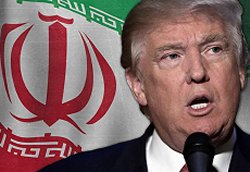
|
- Iran: Eight Prisoners Hanged on Drug Charges
- Daughter of late Iranian president jailed for ‘spreading lies’ - IRAN: Annual report on the death penalty 2016 - Taheri Facing the Death Penalty Again - Dedicated team seeking return of missing agent in Iran - Iran Arrests 2, Seizes Bibles During Catholic Crackdown
- Trump to welcome Netanyahu as Palestinians fear U.S. shift
- Details of Iran nuclear deal still secret as US-Tehran relations unravel - Will Trump's Next Iran Sanctions Target China's Banks? - Don’t ‘tear up’ the Iran deal. Let it fail on its own. - Iran Has Changed, But For The Worse - Iran nuclear deal ‘on life support,’ Priebus says
- Female Activist Criticizes Rouhani’s Failure to Protect Citizens
- Iran’s 1st female bodybuilder tells her story - Iranian lady becomes a Dollar Millionaire on Valentine’s Day - Two women arrested after being filmed riding motorbike in Iran - 43,000 Cases of Child Marriage in Iran - Woman Investigating Clinton Foundation Child Trafficking KILLED!
- Senior Senators, ex-US officials urge firm policy on Iran
- In backing Syria's Assad, Russia looks to outdo Iran - Six out of 10 People in France ‘Don’t Feel Safe Anywhere’ - The liberal narrative is in denial about Iran - Netanyahu urges Putin to block Iranian power corridor - Iran Poses ‘Greatest Long Term Threat’ To Mid-East Security |
Monday 09 August 2010Tensions in a Key Shipping RouteThe Wall Street Journal The strategic Strait of Hormuz has long been the subject of terrorist threats and piracy worries, but has operated free of oil-tanker sabotage since the 1980s. Slicing between Iran and Oman and connecting the Persian Gulf with the Gulf of Oman, the strait is the transit route for tankers carrying roughly 17 million barrels a day—almost 20% of the world's daily oil needs—from key producers such as Saudi Arabia. With such strategic economic importance, U.S. and other Gulf naval forces have for years routinely patrolled the waters in and around the strait, reducing the risk of attacks. Gulf News reported that Oman and Iranian military officials made a joint pledge to protect the strait in the wake of Wednesday's claim by militants that they damaged a Japanese oil tanker last week. Still, terrorists have threatened oil trade in the Gulf, and Iran has threatened tanker traffic through the passageway. In recent years, Somali pirates have launched attacks on ships close by, assaulting at least one merchant ship in recent months just south of the entranceway to the strait, off the coast of Oman. But oil tankers haven't been attacked since the 1980s, when dozens of vessels from various countries got caught in the crossfire of the Iran-Iraq war, during which the two countries attacked each other's ships. Even during the start of the U.S.-led invasion of Iraq in 2003, ships continued to load crude in Persian Gulf ports and transit unhindered through the strait, which is about 21 miles wide at its narrowest point at the mouth of the waterway. |

 Send to a Friend
Send to a Friend
